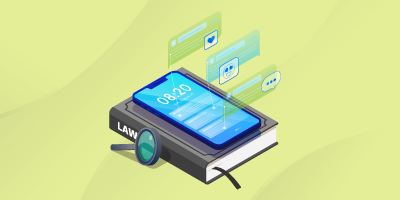Expert Perspectives: This article features an interview with Geoffrey Geftman, Discovery Consultant in Michael Best’s Information Governance and Discovery Services team.
Flexibility is key in negotiating eDiscovery protocols
Q: The first step in an eDiscovery project after data collection is typically processing. Advanced planning can go a long way toward ensuring success. What standard protocols and processes do you recommend for eDiscovery processing?
A: Processing essentially means the ability to cull data using date restrictions, custodians, search terms, pre-filtering, and deduplication. Savvy legal practitioners should adopt an iterative and collaborative approach. First, start with test search terms, then review results with attorneys, and repeat. During this process, participate in ongoing negotiating with opposing counsel until everyone is comfortable with the methods and search terms selected. Being flexible in this area is critical. For example, what happens when both parties agree on search terms, but the resulting data set is too broad? Without flexibility, a body of documents too large for review is very difficult to correct later in the eDiscovery process.
eDiscovery processing and production: Know your standards
Q: What’s the standard protocol in eDiscovery processing?
A: Global deduplication is the standard. Everything else is more of a moving target based on the case. Whatever you can do from an early point to cull your data set is beneficial: Search terms have become the standard because there’s a cost in terms of promotion and hosting. Processing and analytics are often run early with large data sets, since much of the data will be irrelevant with broad collection ranges.
Outlining your production shouldn’t be a point of contention. It should be a meeting place where both sides get together to understand what they need.
Advanced planning in eDiscovery
Q: You recommend advanced planning in eDiscovery production as well – what specifically should practitioners do to ensure success?
A: With production, you often will see a plaintiff side with a small amount of data; the defense side has much more. This often results in a situation where a production may cost more to format than the data itself is worth. The worst case I’ve encountered was about 15-20K pages put into a single PDF without any page breaks. It took about 15 minutes for that PDF just to open and load!
What’s the takeaway? Outlining your production shouldn’t be a point of contention. It should be a meeting place where both sides get together to understand what they need. Courts don’t want to hear data format complaints. Simply taking the time to understand the preferred format, and using a protocol can make it so there are no questions later.
What’s the standard protocol in eDiscovery production?
Because most people are using tools with specific loading capabilities, parties tend to want:
- Page-level images:
- TIFF files when the images are in black and white
- JPG files when color is needed or requested
- Separate, document-level text files
- Native files only when dealing with audio-visual files, files that cannot be imaged, or document types that don’t image well such as Excel or PowerPoint
There are some standard metadata fields, but it is dictated by what’s agreed to by the parties involved – this is another reason to plan ahead and negotiate early.
Negotiating eDiscovery protocols: Best Practices
Q: What protocols exist for eDiscovery practitioners?
A: The best guideline I’ve seen is the Mandatory Initial Discovery Program. It’s a pilot program in the Northern District of Illinois and Arizona that outlines an expedited timeline for eDiscovery. Practitioners have 70 days from initial pleading to produce all electronically stored information (ESI). The biggest benefit of this is that it forces the parties to deal with ESI cooperatively because of the truncated timeline.
In terms of best practices, practitioners should strive to “be the reasonable one in the conversation.” Courts don’t look kindly upon unreasonable stances.
Additionally, educate yourself and use experts where appropriate: eDiscovery and electronic data require special knowledge – and there’s a benefit in working with eDiscovery consultants or vendors and in-house eDiscovery specialists before sitting down with opposing parties.
Judicial opinions: Know your eDiscovery standards
Q: What government and industry group specifications exist for discovery protocols? What about courts’ rules?
A: There are three mistakes I encounter with some frequency:
- Not having any outline agreement in place. Without at least a rough agreement, parties may wind up without any basis for complaint if things go awry. If a court has no real guidance or background in ESI, then you don’t know how it will fall. Even without specifics, some agreement is better than nothing.
- Legal teams coming to a negotiation on search terms before they even process the data. You can’t know what search terms will be effective without getting a general sense of your dataset first. So make sure to take the iterative approach outlined above.
- Many attorneys are hesitant about up-front costs when considering tools or processes that may reduce the initial data set at the outset of a matter. Up-front costs may appear prohibitive; however when compared with the ultimate cost of reviewing a larger data set, the cost-benefit calculation shifts. When analytics can remove thousands of documents from the data set for review, the deployment of sophisticated software can pay for itself and reduce the overall cost of a matter.
About Geoffrey Geftman: Geoffrey brings more than a decade of legal and eDiscovery experience to his work as a discovery consultant. He consults with clients, attorneys, and technical support teams to develop custom workflows and leverage legal technologies in order to create cost-efficient practices and streamlined discovery efforts. Applying his industry experience from both the legal and technological perspectives, Geoffrey bridges the gaps to assist legal teams in developing strategies for responses to production requests and implementation of eDiscovery stipulations to minimize data and exposure for clients. Geoffrey regularly provides software training and legal education presentations to legal teams and litigation support specialists to keep them abreast of developing topics and trends in eDiscovery.
About the Author
From the institute
Corporate Counsel Guide to End-to-End eDiscovery
As an in-house attorney, eDiscovery can often feel like a distraction from the substantive work you want to be doing, but successfully managing eDiscovery – including choosing the right partners – can result in finding better information, more quickly, and less expensively across all your matters.
Clear the Final Merger Hurdle: A Guide to Second Requests in the Age of Analytics
Second Requests are high velocity, high volume, and high visibility — under normal circumstances. Now, as legal departments are facing an unprecedented post-pandemic economy and an ever-growing reliance on digital communication, the demands in this final merger step are higher than ever.




